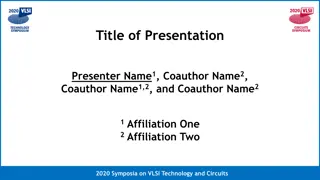
Strategic Pay Plans and Job Evaluation Methods
Discover how to establish strategic pay plans and conduct job evaluations effectively. Learn about factors determining pay rates, equity impact, legal considerations, and market-competitive pay plan creation. Explore job evaluation methods and the importance of benchmark jobs in determining wage curves.
Download Presentation

Please find below an Image/Link to download the presentation.
The content on the website is provided AS IS for your information and personal use only. It may not be sold, licensed, or shared on other websites without obtaining consent from the author. If you encounter any issues during the download, it is possible that the publisher has removed the file from their server.
You are allowed to download the files provided on this website for personal or commercial use, subject to the condition that they are used lawfully. All files are the property of their respective owners.
The content on the website is provided AS IS for your information and personal use only. It may not be sold, licensed, or shared on other websites without obtaining consent from the author.
E N D
Presentation Transcript
Establishing Strategic Pay Plans By: 1. Ester Aprilia Lalenoh 2. Manuel Bias Azhari 3. Riski Basith
List The basic factors determining pay rates Employee compensation Direct financial payment Indirect financial payment
Equity and its impact on pay rates Equity theory of motivation External equity Procedural equity Internal equity Individual equity
Legal consideration in compensation
Define and give an example of how to conduct a job evaluation Job evaluation methods Prepraring for the job evaluation Compensable factors Job evaluation methods Ranking Select and group jobs Obtain job information Select Rank job Combine ratings compensable factors
Job evaluation methods Job classification Job evaluation methods Point methods Computerized job evaluations
1. Choose Benchmark Jobs 2. Select 3. Assign Weights to compensable factors 4. Convert percentages to points for each factor Compensable Factors 6. Determine for each factor its factor degrees point 7. Review job descriptions and job specifications 5. Define each factor s degrees 8. Evaluate the job HOW TO CREATE A MARKET-COMPETITIVE PAY PLAN 16 Steps
8.EVALUATE THE JOBS WHAT IS A MARKET-COMPETITIVE PAY PLAN? WHAT ARE WAGE CURVES?
1. Choose Benchmark Jobs 2. Select 3. Assign Weights to compensable factors 4. Convert percentages to points for each factor Compensable Factors 6. Determine for each factor its factor degrees point 7. Review job descriptions and job specifications 5. Define each factor s degrees 8. Evaluate the job HOW TO CREATE A MARKET-COMPETITIVE PAY PLAN 10. Conduct a Market Analysis : Salary Survey 11. Draw the Market (Exsternal) Wage Curve 12. Compare and Adjust Current and Market Wage Rates for Jobs 9. Draw the current (internal) wage curve 13. Develop Pay Grades
13. DEVELOP PAY GRADES Pay (or wage) Grade Determining the number of pay grades
1. Choose Benchmark Jobs 2. Select 3. Assign Weights to compensable factors 4. Convert percentages to points for each factor Compensable Factors 6. Determine for each factor its factor degrees point 7. Review job descriptions and job specifications 5. Define each factor s degrees 8. Evaluate the job HOW TO CREATE A MARKET-COMPETITIVE PAY PLAN 10. Conduct a Market Analysis : Salary Survey 11. Draw the Market (Exsternal) Wage Curve 12. Compare and Adjust Current and Market Wage Rates for Jobs 9. Draw the current (internal) wage curve 13. Develop Pay Grades 14. Establish Rate Ranges
Developing Rate Ranges 14. ESTABLISH RATE RANGES
1. Choose Benchmark Jobs 2. Select 3. Assign Weights to compensable factors 4. Convert percentages to points for each factor Compensable Factors 6. Determine for each factor its factor degrees point 7. Review job descriptions and job specifications 5. Define each factor s degrees 8. Evaluate the job HOW TO CREATE A MARKET-COMPETITIVE PAY PLAN 10. Conduct a Market Analysis : Salary Survey 11. Draw the Market (Exsternal) Wage Curve 12. Compare and Adjust Current and Market Wage Rates for Jobs 9. Draw the current (internal) wage curve 16. Correct Outof- Line Rates 13. Develop Pay Grades 14. Establish Rate Ranges 15. Address Remaining Jobs
PRICING MANAGERIAL AND PROFESSIONAL JOBS Compensating Executives and Managers Base Pay Short-term incentives Long-term incentives Executive Benefits and perks What Determines Executive Pay? Job Complexity Ability To Pay Human Capital Managerial Job Evaluation Compensating Professional Employees
Explain the diffrence between competency- based and traditional pay plans ! CONTEMPORARY TOPICS IN COMPENSATION Competency-Based Pay WHAT IS COMPETENCY-BASED PAY? WHY USE COMPETENCY-BASED PAY? COMPETENCY-BASED PAY? COMPETENCY-BASED PAY IN PRACTICE GENERAL MILLS EXAMPLE THO BOTTOM LINE ON COMPETENCY-BASED PAY
List and explain six important trends in compensation management! Broadbanding - PROS AND CONS Actively Managing Compensation Allocations, and Talent Management Comparable Worth - THE PAY GAP
Board Oversigth of Executive Pay Total Rewards and Tomorrow s Pay Programs Improving Productivity through HRIS






















